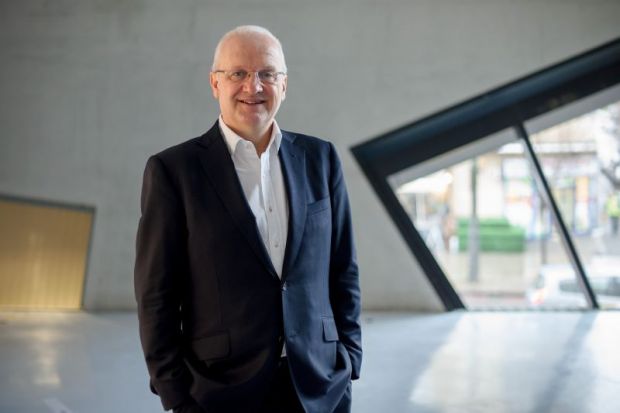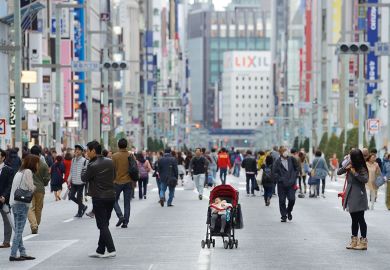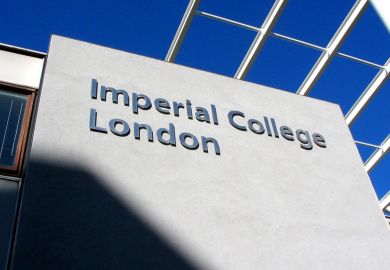Those searching for the vice-chancellor’s office at London Metropolitan University these days are in for a surprise: there isn’t one.
Instead of the old spacious office suite complete with boardroom table and oil paintings, there is a small desk in the corner of an open-plan office.
“We all get the same thickness of carpet here,” joked John Raftery about the revised set-up, which also sees pro vice-chancellors dotted around the brightly lit office overlooking Holloway Road, in north London.
Professor Raftery, who will step down as vice-chancellor later this year, insisted that he preferred the “more communal” arrangements for his team, but the office downsizing is also an apt metaphor for the shrinking university in recent years.
As recently as 2011-12, it was one of the UK’s largest higher education institutions, with 23,500 students sprawled across four central London sites; today, it has just over 12,000 students who, from 2019, will be located on a single refurbished site in Islington.
This year’s undergraduate intake illustrates how headcount has fallen: the 2,680 full-time students admitted is well down on the 7,210 admitted in 2011-12 – the final year before annual tuition fees rose to £9,000 – and well below the 4,000 enrolled when Professor Raftery took over in August 2014.
Attempting to turn around this decline was made far tougher by the government’s decision to abolish student number controls in England in 2015.
“It is difficult to say successful institutions shouldn’t be allowed to grow,” said Professor Raftery of the decision to unleash market-style competition on higher education, “but you have to ask the question about institutions who are less successful [in recruiting]…particularly when they have a proud history of transforming student lives.”
“It was destabilising and it’s not obvious that higher education is best configured as a market,” he added.
With student numbers falling, staff have been let go, with some 400 being made redundant in the last major cost-cutting round – which Professor Raftery called the “hardest part” of his four years in charge. “It is a great testimony that we’ve managed to improve teaching quality and student outcomes while having fewer people,” he said.
This improved performance, as well as London Met’s solid finances, is what Professor Raftery wants his tenure to be judged on.
“There is money in the bank, no bank borrowing, we invested in new teaching spaces and there is more of this to come,” he said. Graduate employment is up significantly since 2014, with 75 per cent of graduates in highly skilled employment six months after graduation and 95 per cent in some kind of job. That is a huge achievement for London Met, Professor Raftery argued, given that about two-thirds of students come from highest two deciles of the multiple deprivation index – a measure that takes into account not just a student’s family income, but other factors such as disability, education and access to housing.
London Met, where some 60 per cent of students are from ethnic minorities and half are over 25, has also overtaken 45 universities on the National Student Survey, with its overall satisfaction score hitting 80 in 2016 before dipping to 78 last year.
The improvements are arguably more impressive given the lack of a resource on which so many universities rely: international students.
Within six weeks of arriving at London Met in August 2014, Professor Raftery helped to win back the university’s highly trusted status that allows it to admit international students, after it was snatched away in a blaze of publicity two years earlier.
But tougher visa rules introduced that year by Theresa May, then home secretary, have hampered efforts to rebuild international student numbers to 2012 levels, when they stood at about 2,000, Professor Raftery said.
“We thought we would slowly build back international students, but it has been quite difficult,” he said. “It’s not about the money,” he added, saying that the 600 current international students, including many from the US, bring “amazing benefits to other students on each of our programmes,” he added.
London Met has, in this respect, been one of the first to follow Ms May’s wish as home secretary, according to leaked documents in 2015, that universities should “not [be] so dependent on international students”, reflected Professor Raftery.
While London Met’s bronze in last year’s teaching excellence framework was not a surprise, the institution is a “rapidly improving bronze”, Professor Raftery said, although its improving NSS scores will not count as much because this metric has been downgraded for this year’s exercise. “It’s the only metric which actually measures teaching quality, so it’s a shame that it’s been halved in importance,” he said.
Professor Raftery insisted that he always planned to leave within five years, but is adamant that he leaves London Met in a stronger position. “I think some [vice-chancellors] stay a bit too long – I did not want to do that,” he said, adding that he believed he has “developed an institution that routinely identifies and fixes its own problems”.
后记
Print headline: London Met: smaller but more successful




